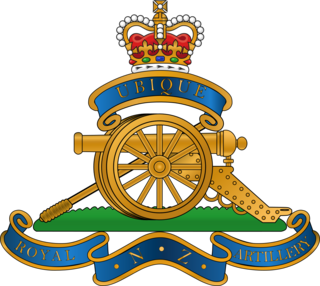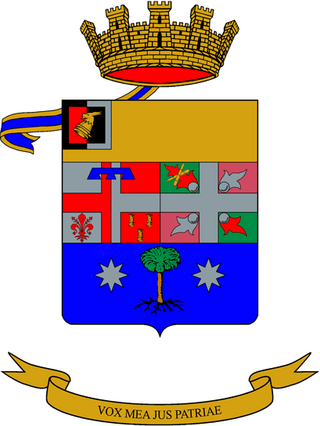
The 2nd New Zealand Division, initially the New Zealand Division, was an infantry division of the New Zealand Military Forces during the Second World War. The division was commanded for most of its existence by Lieutenant-General Bernard C. Freyberg. It fought in Greece, Crete, the Western Desert and Italy. In the Western Desert Campaign, the division played a prominent role in the defeat of German and Italian forces in the Second Battle of El Alamein and the British Eighth Army's advance to Tunisia.

The Royal Regiment of New Zealand Artillery is the artillery regiment of the New Zealand Army. It is effectively a military administrative corps, and can comprise multiple component regiments. This nomenclature stems from its heritage as an offshoot of the British Army's Royal Artillery. In its current form it was founded in 1947 with the amalgamation of the regular and volunteer corps of artillery in New Zealand. In 1958 in recognition of services rendered it was given the title the Royal Regiment of New Zealand Artillery.

The 3rd New Zealand Division was a division of the New Zealand Military Forces. Formed in 1942, it saw action against the Japanese in the Pacific Ocean Areas during the Second World War. The division saw action in the Solomon Islands campaign during 1943–1944, during which it undertook landings on Vella Lavella, the Treasury Islands and the Green Islands. Due to manpower shortages, for most of its existence the division consisted of only two infantry brigades in addition to support personnel, with its third brigade being disbanded shortly after formation. In 1944, manpower shortages in the New Zealand economy became acute led to the disbandment of the division. The majority of its manpower was returned to civilian employment, although around 4,000 men were sent to Italy to reinforce the 2nd Division, seeing further action before the end of the war in May 1945.
The 92nd (Loyals) Light Anti-Aircraft Regiment was a mobile air defence unit of the British Army's Royal Artillery (RA) during World War II. The regiment had a special role on D-Day, and afterwards served throughout the campaign in North West Europe.
This is the order of battle for the ground forces involved in Operation Crusader, a World War II battle between the British Commonwealth and the European Axis Powers of Germany and Italy in North Africa between 18 November – 30 December 1941.
During the Second World War the British Army deployed armoured divisions and independent armoured and tank brigades.

The Manx Regiment – the 15th Light Anti Aircraft Regiment, Royal Artillery – was raised in 1938 as a Territorial Army (TA) unit of the British Army. It recruited on the Isle of Man and formed part of Anti-Aircraft Command at the outbreak of the Second World War. The regiment was posted to the Middle East in November 1940, serving in the Western Desert, East Africa and Crete. In August 1942 it became the air defence regiment for the 7th Armoured Division. It served with the division through the North African, Italian and North West European campaigns. It was reformed in the postwar TA as 515 Light Anti-Aircraft Regiment before being reduced to a staff troop in 42nd (Lancashire) Division in 1955.

45th Light Anti-Aircraft Regiment, Royal Artillery, was a British Territorial Army (TA) unit formed in July 1940. After serving in Anti-Aircraft Command during the Battle of Britain and The Blitz, it went to North Africa as part of Operation Torch and fought in Tunisia and Italy. It ended World War II as a garrison regiment.
1st Anti-Aircraft Brigade was an Air Defence formation of the British Army, during the Second World War, and served in the Battle of France and during The Blitz. It then transferred to the Middle East, where it defended the Eighth Army's lines of communication during the final phases of the North African Campaign.
Major General Walter Sneddon McKinnon, was an officer in the New Zealand Army. He joined the military in 1935 and served in the Second World War with various artillery units of the Second New Zealand Expeditionary Force. After the war he held a series of senior positions in the army, culminating with a term as Chief of the General Staff from 1965 to 1967. In his retirement, he was Chairman of the New Zealand Broadcasting Corporation.

The 1st Devonshire Artillery Volunteers and its successor units served in the British Army's Reserve Forces from 1859 to 1961. During World War I it carried out garrison duty in British India but went on to see active service in the Third Anglo-Afghan War. Converting to an air defence role before World War II its units participated in the Norwegian campaign and the Dunkirk evacuation, the Battle of Britain and then the campaigns in North Africa, Italy, and Burma

The 90th Light Anti-Aircraft Regiment, Royal Artillery, was an air defence unit of the British Army during World War II. Initially raised as an infantry battalion of the South Wales Borderers in 1940, it transferred to the Royal Artillery in 1941. It served with 1st Infantry Division in the final stages of the Tunisian Campaign, distinguished itself in the Anzio landings and subsequent fighting, and continued serving in Italy before being disbanded at the beginning of 1945.

The 91st Light Anti-Aircraft Regiment, Royal Artillery, was an air defence unit of the British Army during World War II. Initially raised as an infantry battalion of the South Staffordshire Regiment in 1940, it transferred to the Royal Artillery in late 1941. It served with 4th Infantry Division in Tunisia and Italy until it was disbanded at the end of 1944.

The 105th Light Anti-Aircraft Regiment, Royal Artillery, was an air defence unit of the British Army during World War II. Initially raised as an infantry battalion of the Dorsetshire Regiment in 1940, it transferred to the Royal Artillery in 1941. It served with V Corps in the Allied landings in North Africa. It later defended vital points during the campaign in Italy until it was disbanded in June 1944 to provide infantry reinforcements.

15th Anti-Aircraft Brigade was an air defence formation of the Royal Artillery which saw service during the middle years of the Second World War. The brigade was formed in Gibraltar to control those anti-aircraft (AA) units based there and disbanded shortly after the air threat had been diminished in 1944. The brigade was later reformed in 1947 as part of the post-war regular army, but disbanded in 1957 following the end of the AA era.

The 7th Anti-Tank Regiment was an anti-tank artillery regiment of the New Zealand Military Forces raised during the Second World War. It saw service as part of the 2nd New Zealand Division during the Greek, North African, Tunisian and Italian campaigns, before being disbanded in December 1945.

The 29th Light Anti-Aircraft Regiment was an air defence regiment of the New Zealand Military Forces raised during the Second World War. It saw service as part of the 3rd New Zealand Division during the Solomon Islands campaign and was disbanded in October 1944.

The 52nd Light Anti-Aircraft Regiment, was a Royal Artillery (RA) air defence unit of Britain's part-time Territorial Army (TA) converted from a field artillery unit just before the outbreak of World War II. It served in the Battle of France, shooting down a large number of aircraft before being evacuated from Dunkirk. It was then sent to the Mediterranean, where detached batteries were destroyed in the fighting in Greece and Crete. The reformed regiment then took part in the defence of the Suez Canal and later in the Italian Campaign. It continued in the postwar TA until 1955 when it merged with other units in Lancashire.

The 56th Light Anti-Aircraft Regiment, Royal Artillery, was a Royal Artillery (RA) air defence unit of Britain's part-time Territorial Army (TA) raised as a duplicate unit just before the outbreak of the Second World War. It served in the Norwegian Campaign and then joined 8th Armoured Division. It was sent to Egypt and participated in the Second Battle of El Alamein and the subsequent pursuit across North Africa. It then fought in the Italian Campaign, including defending the Salerno and Anzio beachheads. It often operated under US command, on one occasion in an anti-tank role. The regiment reformed as heavy AA artillery in the postwar TA and continued until 1955 when it merged with other units in Lancashire.

The 14th Artillery Regiment "Ferrara" is an inactive field artillery regiment of the Italian Army, which was based in Trieste in Friuli-Venezia Giulia. Originally an artillery regiment of the Royal Italian Army, the regiment was formed in 1888 and served in World War I on the Italian front. In 1935 the regiment was assigned to the 23rd Infantry Division "Ferrara", with which the regiment fought in the Greco-Italian War of World War II. The division and regiment were located in Montenegro, when the Armistice of Cassibile was announced on 8 September 1943, and shortly thereafter were disbanded by German forces.









